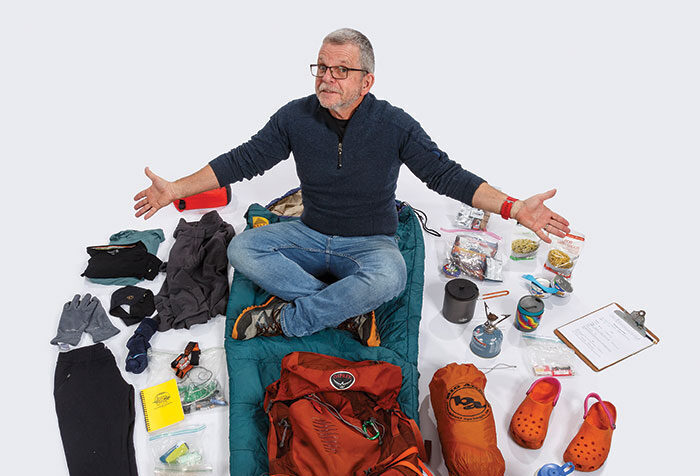We aren’t gear geeks here at GetHiking! But we do love what we love.
Below is some of what we love — and why we love it. Click on the link for more information; in some cases, links to the item on Amazon are provided. We will update this list regularly.
Clothes
The Buff
 Twice a year we endorse the Buff, that stretch tube of microfibre fabric that can be worn a dozen ways — as ear muffs, as cowl, as hat, as balaclava, as blindfold for a nice nap on a sunny day. Most of those are winter adaptations. Come summer, the Buff makes a dandy lightweight headband to help you keep the sweat out of your eyes. When you enter a meadow or other clearing, pull it over the top of your head to protect your head from sunlight. And when you hit a cool creek? Dip it in the water and give yourself — your face and neck in particular, a cooling bath. Encounter a sandstorm? You get the picture. Check it out here.
Twice a year we endorse the Buff, that stretch tube of microfibre fabric that can be worn a dozen ways — as ear muffs, as cowl, as hat, as balaclava, as blindfold for a nice nap on a sunny day. Most of those are winter adaptations. Come summer, the Buff makes a dandy lightweight headband to help you keep the sweat out of your eyes. When you enter a meadow or other clearing, pull it over the top of your head to protect your head from sunlight. And when you hit a cool creek? Dip it in the water and give yourself — your face and neck in particular, a cooling bath. Encounter a sandstorm? You get the picture. Check it out here.
Smartwool Merino Beanie
 I’ve been reminded these past few frigid weeks of how much I love my Smartwool Merino Beanie. I’m not a Smartwool devotee in other areas, but I do love the beanie: it’s snug but not tight, lightweight and compactable (I can stuff it in a coat pocket when I warm up), and it’s durable. It’s one piece of gear I don’t need to think about (except when I can’t find it), and for what it is, it’s pretty inexpensive, priced at $25. Check it out here.
I’ve been reminded these past few frigid weeks of how much I love my Smartwool Merino Beanie. I’m not a Smartwool devotee in other areas, but I do love the beanie: it’s snug but not tight, lightweight and compactable (I can stuff it in a coat pocket when I warm up), and it’s durable. It’s one piece of gear I don’t need to think about (except when I can’t find it), and for what it is, it’s pretty inexpensive, priced at $25. Check it out here.
Driving shoes
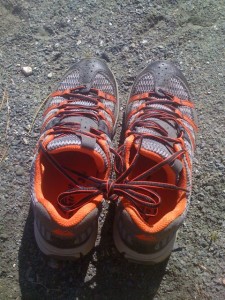 You take a great hike, get back to the car and realize your boots are caked in mud. Makes you wished you’d packed a pair of shoes for the drive home. But who wants to buy an extra pair of shoes just for driving? No one, of course. And you don’t have to. Simply take the hiking shoes you’re ready to decommission and use those instead. They’re comfy, and they still have a little life left (though not enough to hike in). The perfect solution. And good for your car, too.
You take a great hike, get back to the car and realize your boots are caked in mud. Makes you wished you’d packed a pair of shoes for the drive home. But who wants to buy an extra pair of shoes just for driving? No one, of course. And you don’t have to. Simply take the hiking shoes you’re ready to decommission and use those instead. They’re comfy, and they still have a little life left (though not enough to hike in). The perfect solution. And good for your car, too.
Treat yourself (to socks!)
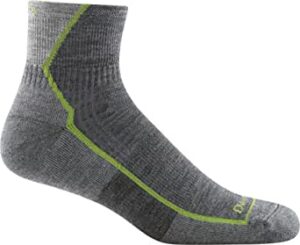 We don’t have a specific gear recommendation this week. Rather, an admonishment to treat yourself to a new piece of gear. Maybe it’s a piece of gear you don’t necessarily need, but a piece of gear you really want (packs fall into this category for me). Maybe it is a piece of equipment you need, but have been putting off because of the cost. Here’s a thought about that: Buy it now and you’ll have a full hiking season to use it — makes it more cost effective, you know? March yourself down to your favorite outfitter — again, now! — with the promise to not return home empty handed.
We don’t have a specific gear recommendation this week. Rather, an admonishment to treat yourself to a new piece of gear. Maybe it’s a piece of gear you don’t necessarily need, but a piece of gear you really want (packs fall into this category for me). Maybe it is a piece of equipment you need, but have been putting off because of the cost. Here’s a thought about that: Buy it now and you’ll have a full hiking season to use it — makes it more cost effective, you know? March yourself down to your favorite outfitter — again, now! — with the promise to not return home empty handed.
Personally, I plan to be hiking this weekend in a new pair of my favorite sock: the Darn Tough Men’s Quarter Midnight Hiker. Snug, durable, and long-lasting. Check ‘em out here.
Marmot Precip
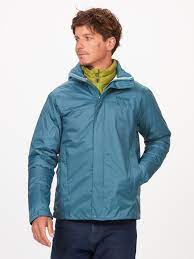 Here’s the thing about rain jackets: you can spend $100 on a rain jacket, you can spend $500 on a rain jacket. And both work about the same, especially in warm weather. That’s why we’ve long gone for the Marmot Precip EcoJacket, a lightweight beast that that does an especially good job — for a year or two. It excels in warm weather — that is, temperatures much above 60, above which you’re likely to get as wet from working up a sweat as you are from getting soaked by rain. It’s got zip pits for ventilation, a couple of pockets, and right now, if you buy one in certain colors you can get it for a fraction of its retail price of around $100. Check ‘em out here.
Here’s the thing about rain jackets: you can spend $100 on a rain jacket, you can spend $500 on a rain jacket. And both work about the same, especially in warm weather. That’s why we’ve long gone for the Marmot Precip EcoJacket, a lightweight beast that that does an especially good job — for a year or two. It excels in warm weather — that is, temperatures much above 60, above which you’re likely to get as wet from working up a sweat as you are from getting soaked by rain. It’s got zip pits for ventilation, a couple of pockets, and right now, if you buy one in certain colors you can get it for a fraction of its retail price of around $100. Check ‘em out here.
Warm weather socks
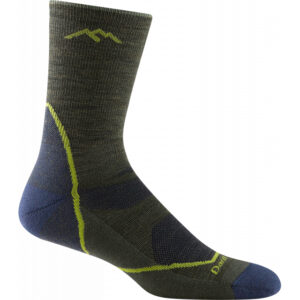 We’ve had our first 80-degree hiking days of the season — and the beginning of the mysterious “sweaty foot season.” Why, we wonder, are our feet suddenly hot and sweaty during a hike? I mean, I haven’t changed a thing, and yet … . And yet that’s the problem — you need to change a thing, that thing being your socks. Those wool socks you’ve been sporting all winter, the ones that have kept your feet nice and toasty? They may be too much for warm weather hiking. Most hiking sock makers make socks for a variety of conditions; often, you can tell their suitability for warm weather hiking based on their cushioning. Socks with medium and heavy cushioning will make your feet sweat; switch to a lightly cushioned sock and to either an ankle-length or crew sock: come summer, cool feet are happy feet. For more on what makes a good summer hiking sock, check out this post from BestHiking.net, which also makes five sock recommendations (see photo).
We’ve had our first 80-degree hiking days of the season — and the beginning of the mysterious “sweaty foot season.” Why, we wonder, are our feet suddenly hot and sweaty during a hike? I mean, I haven’t changed a thing, and yet … . And yet that’s the problem — you need to change a thing, that thing being your socks. Those wool socks you’ve been sporting all winter, the ones that have kept your feet nice and toasty? They may be too much for warm weather hiking. Most hiking sock makers make socks for a variety of conditions; often, you can tell their suitability for warm weather hiking based on their cushioning. Socks with medium and heavy cushioning will make your feet sweat; switch to a lightly cushioned sock and to either an ankle-length or crew sock: come summer, cool feet are happy feet. For more on what makes a good summer hiking sock, check out this post from BestHiking.net, which also makes five sock recommendations (see photo).
The little things that really help
50 feet of cord
 It’s not one of the 10 Essentials, it likely comes in at 11th. But a good run of hiking cord — reflective, if possible, with a break strength of around 225, 250 pounds — is well worth the 2.5-ounce investment. Rain moving in and you need to throw up a tarp? You’ve got your ridgeline. Suddenly hit a rock scramble that’s difficult to maneuver in a pack (especially a backpack)? You’ve got your rope to hoist your gear. An unruly hiking companion who needs restraining? Well, perhaps not. But you get the point. Staves off those woeful moments when you find yourself saying, “If only I had a rope.”
It’s not one of the 10 Essentials, it likely comes in at 11th. But a good run of hiking cord — reflective, if possible, with a break strength of around 225, 250 pounds — is well worth the 2.5-ounce investment. Rain moving in and you need to throw up a tarp? You’ve got your ridgeline. Suddenly hit a rock scramble that’s difficult to maneuver in a pack (especially a backpack)? You’ve got your rope to hoist your gear. An unruly hiking companion who needs restraining? Well, perhaps not. But you get the point. Staves off those woeful moments when you find yourself saying, “If only I had a rope.”
Freezer Ziplocs
 You do so look forward to lunch on a long day hike. Even if it’s simply a robust PBJ, brimming with chunky Skippy and oozing with strawberry Smucker’s, it’s a key component to a successful hike. Now imagine your chagrin upon opening your pack come noon and discovering the flimsy plastic sandwich bag you’ve entrusted with your tasty repast didn’t withstand the impact of that tumble you took: your PBJ has exploded beyond recognition and now covers the inside of your pack. Tsk.
You do so look forward to lunch on a long day hike. Even if it’s simply a robust PBJ, brimming with chunky Skippy and oozing with strawberry Smucker’s, it’s a key component to a successful hike. Now imagine your chagrin upon opening your pack come noon and discovering the flimsy plastic sandwich bag you’ve entrusted with your tasty repast didn’t withstand the impact of that tumble you took: your PBJ has exploded beyond recognition and now covers the inside of your pack. Tsk.
That likely wouldn’t be the case had you used a gallon Ziploc Freezer Bag. And yes, Ziploc, because that is the choice of the Appalachian Mountain Club, which notes in a blog: “They’re thicker than your average sandwich bag, which averages 1.5 mil in thickness (a mil is 1/1000th of an inch). Most freezer bags are at least 2 mil; Ziploc brand freezer bags are some of the thickest at 2.7 mil.” Further, notes the AMC: “What’s more, a thickness of 2 mil or more allows manufacturers to produce the closure strip at the same time the bag is produced. On thinner sandwich bags, the closure strip has to be laminated on (and can potentially peel off with repeated use).”
What’s more, if you crave something hot for lunch, you can fill a bag with soup mix, ramen, whatever and add boiling water! The bag will hold and you can dine straight from it. Another plus: Ziploc Freezer Bags also relatively inexpensive.
The basic Bic lighter
 “I can’t get this to ignite,” Kimberly said — for the third time — as she punched away at the recalcitrant pushbutton igniter on her camp stove. “Can I borrow your lighter? Again?” Thank heavens and a hot dinner for the basic Bic lighter. The ubiquitous point-of-purchase device that costs maybe a buck fifty and can be your best friend on the trail, from getting your dinner underway with your cookstove to starting the campfire that will keep you and the crew gabbing late into the night. Buy one, tuck it away with your cookset. Actually, buy two: stick the second in your hip belt pocket or your pack brain and forget it’s there — until you need it.
“I can’t get this to ignite,” Kimberly said — for the third time — as she punched away at the recalcitrant pushbutton igniter on her camp stove. “Can I borrow your lighter? Again?” Thank heavens and a hot dinner for the basic Bic lighter. The ubiquitous point-of-purchase device that costs maybe a buck fifty and can be your best friend on the trail, from getting your dinner underway with your cookstove to starting the campfire that will keep you and the crew gabbing late into the night. Buy one, tuck it away with your cookset. Actually, buy two: stick the second in your hip belt pocket or your pack brain and forget it’s there — until you need it.
Backpacking thermometer
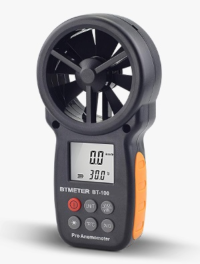 It’s an odd thing to be obsessed over just how cold it gets on a trip, but it’s an odd thing that just about all of us are obsessed by. Once on the Appalachian Trail north of Asheville we were especially curious about the overnight low. The forecast was for 19 degrees, but at an elevation 2,000 feet below ours. We speculated it might get as low as 17. Then, Saturday we ran into a couple of thru-hikers who said it was 13 at their camp, which was about 1,000 vertical feet below ours. It’s all about bragging rights, I reckon. Anyway, next time we head out we plan to have an accurate take on the temperature using one of five thermometers recently tested by AmericanStateParks.org. The candidates range from a $6.49 keychain thermometer to a $29.88 digital readout. Their top choice: the BTMeter Anemometer BT-100 . Read the review here.
It’s an odd thing to be obsessed over just how cold it gets on a trip, but it’s an odd thing that just about all of us are obsessed by. Once on the Appalachian Trail north of Asheville we were especially curious about the overnight low. The forecast was for 19 degrees, but at an elevation 2,000 feet below ours. We speculated it might get as low as 17. Then, Saturday we ran into a couple of thru-hikers who said it was 13 at their camp, which was about 1,000 vertical feet below ours. It’s all about bragging rights, I reckon. Anyway, next time we head out we plan to have an accurate take on the temperature using one of five thermometers recently tested by AmericanStateParks.org. The candidates range from a $6.49 keychain thermometer to a $29.88 digital readout. Their top choice: the BTMeter Anemometer BT-100 . Read the review here.
No-waste doggie water bottle
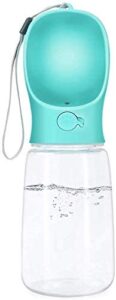 You love hiking with Farfel, but there is one thing that drives you nuts: When you think it’s time for a drink, Farfel doesn’t always agree. You fill his collapsible bowl with precious water from your personal stash, he looks at it, looks at you, looks back at it, then becomes fascinated with a dust mote dancing by. Grrr. If you can relate, then check out the Avelora Dog Water Bottle. Farfel looks thirsty, you pull out the bottle, flip a switch and fill the reservoir on the end, then offer Farfel a refreshing drink. Should Farfel decline, tilt the reservoir upright and the water flows back into the 12-ounce bottle, for future consumption, should Farfel develop a thirst. Learn more here.
You love hiking with Farfel, but there is one thing that drives you nuts: When you think it’s time for a drink, Farfel doesn’t always agree. You fill his collapsible bowl with precious water from your personal stash, he looks at it, looks at you, looks back at it, then becomes fascinated with a dust mote dancing by. Grrr. If you can relate, then check out the Avelora Dog Water Bottle. Farfel looks thirsty, you pull out the bottle, flip a switch and fill the reservoir on the end, then offer Farfel a refreshing drink. Should Farfel decline, tilt the reservoir upright and the water flows back into the 12-ounce bottle, for future consumption, should Farfel develop a thirst. Learn more here.
Headlamps
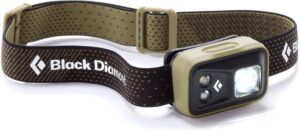 Headlamps, like diaries, are personal things. Some folks just want a durable torch that’s cheap and shines a light. They don’t care how much it weighs (Heckuva good way to build neck muscles!). For them, a basic $13 200 lumen Energizer lamp with three modes will suffice. Others want the flashiest thing on the market, say, the Zebralight H600w Mk IV, with a whopping 1400 lumens (be seen from space!), $89 price tag be danged. And there’s a passel of options in-between. Which is why we refer you to the GearLab’s most recent look at the subject, “The Hunt for the Best Headlamps.” Over a six-year period they’ve reviewed 63 headlamps; in this article, they give their thoughts on 27 of them. Check it out here.
Headlamps, like diaries, are personal things. Some folks just want a durable torch that’s cheap and shines a light. They don’t care how much it weighs (Heckuva good way to build neck muscles!). For them, a basic $13 200 lumen Energizer lamp with three modes will suffice. Others want the flashiest thing on the market, say, the Zebralight H600w Mk IV, with a whopping 1400 lumens (be seen from space!), $89 price tag be danged. And there’s a passel of options in-between. Which is why we refer you to the GearLab’s most recent look at the subject, “The Hunt for the Best Headlamps.” Over a six-year period they’ve reviewed 63 headlamps; in this article, they give their thoughts on 27 of them. Check it out here.
Picaridin insect repellant
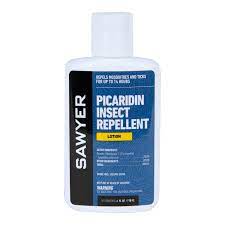 In today’s “Resources” section we provide a resource for folks who really like to investigate every conceivable option before making a decision. That would not describe the GetHiking! braintrust, to employ that term lightly. When it comes to insect repellent we go with picaridin over DEET for one simple reason: Both will kill mosquitoes, but picaridin has been shown to do a better job of keeping skeeters at bay. Simple decision for us. Check it out here.
In today’s “Resources” section we provide a resource for folks who really like to investigate every conceivable option before making a decision. That would not describe the GetHiking! braintrust, to employ that term lightly. When it comes to insect repellent we go with picaridin over DEET for one simple reason: Both will kill mosquitoes, but picaridin has been shown to do a better job of keeping skeeters at bay. Simple decision for us. Check it out here.
Extra washers for your Sawyer filter
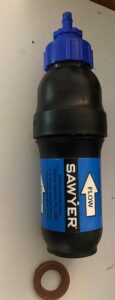 I’d found a spot on the stream with decent flow, took a seat, reached into my water treatment stuff sack to grab my Sawyer filter and — odds are if you have a Sawyer you know what’s coming next: the white plastic gasket that assures a tight fit between dirty bag and filter, was gone. To quote Ralphie, “Oh, fudge!” Despite the fact it pops out every time I use it, I hadn’t gone the extra step to pack a spare. Bree, however, had. “I always bring an extra; I give ‘em away all the time.” Only smart Bree didn’t have an extra official replacement, which can cost upwards of a buck a piece — she’d gone to the hardware store and got a bag of suitable washers for about a tenth the cost. The dimensions, to make sure you get a tight fit: 0.99 x 0.99 x 0.13 inches.
I’d found a spot on the stream with decent flow, took a seat, reached into my water treatment stuff sack to grab my Sawyer filter and — odds are if you have a Sawyer you know what’s coming next: the white plastic gasket that assures a tight fit between dirty bag and filter, was gone. To quote Ralphie, “Oh, fudge!” Despite the fact it pops out every time I use it, I hadn’t gone the extra step to pack a spare. Bree, however, had. “I always bring an extra; I give ‘em away all the time.” Only smart Bree didn’t have an extra official replacement, which can cost upwards of a buck a piece — she’d gone to the hardware store and got a bag of suitable washers for about a tenth the cost. The dimensions, to make sure you get a tight fit: 0.99 x 0.99 x 0.13 inches.
Thanks again, Bree.
Headbands and wrist bands
 Tube socks — I get why those went out of style. But headbands and wristbands? Talk about utilitarian and groovy gear. If you weren’t around in the ‘70s (or were and can’t remember), sweatbands were a go-to piece of gear for sweating basketball players. A headband kept the sweat out of your eyes, wristbands kept the sweat from running down your arms and saturating your hands, making ball handling a challenge. But toss on a combo of headband and wristbands and you were one cool — and dry — athlete. And you can still get them! A company called Suddora sells them for just $9.99 a set! That’s right, headband and wristbands yours for under $10. Worry not about blurred vision obliterating rocks and roots, nor about being able to hold on to your poles. 80 percent cotton, 12 percent spandex, 8 percent nylon; check ‘em, out here.
Tube socks — I get why those went out of style. But headbands and wristbands? Talk about utilitarian and groovy gear. If you weren’t around in the ‘70s (or were and can’t remember), sweatbands were a go-to piece of gear for sweating basketball players. A headband kept the sweat out of your eyes, wristbands kept the sweat from running down your arms and saturating your hands, making ball handling a challenge. But toss on a combo of headband and wristbands and you were one cool — and dry — athlete. And you can still get them! A company called Suddora sells them for just $9.99 a set! That’s right, headband and wristbands yours for under $10. Worry not about blurred vision obliterating rocks and roots, nor about being able to hold on to your poles. 80 percent cotton, 12 percent spandex, 8 percent nylon; check ‘em, out here.
Digital zipperpull thermometer
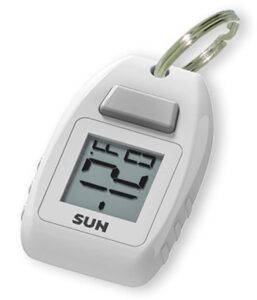 How many times have you been on a hot/cold hike and someone says it must be at least 95/25 degrees? Now, you know they’re high/low, but without proof, who’s to say with certainty that they’re wrong? That’s why you need to spring for the Sun Co. Digital Zipogage, a digital thermometer that clips to your zipperpull, and at the push of a button gives you a more accurate temperature reading. End of debate — and for only about $21, by going here.
How many times have you been on a hot/cold hike and someone says it must be at least 95/25 degrees? Now, you know they’re high/low, but without proof, who’s to say with certainty that they’re wrong? That’s why you need to spring for the Sun Co. Digital Zipogage, a digital thermometer that clips to your zipperpull, and at the push of a button gives you a more accurate temperature reading. End of debate — and for only about $21, by going here.
Anker 325 Power Bank
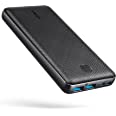 Frankly, there are a lot of good portable power banks out there that get good reviews and that can be had for not much more than $20. But if you want to be absolutely sure you don’t lose a phone charge — and don’t mind helping out your fellow campers to boot, check out the Anker 325 Power Bank. With 20,000mAh it can provide 5 full charges to just about any cell phone. And with two ports you can charge two phones at the same time. About $40.
Frankly, there are a lot of good portable power banks out there that get good reviews and that can be had for not much more than $20. But if you want to be absolutely sure you don’t lose a phone charge — and don’t mind helping out your fellow campers to boot, check out the Anker 325 Power Bank. With 20,000mAh it can provide 5 full charges to just about any cell phone. And with two ports you can charge two phones at the same time. About $40.
Sewing kit
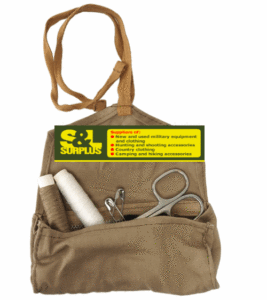 For everything from one-hour day hikes to multiday backpack trips, it pays to have a sewing kit in your arsenal. For mending everything from blisters to rips in your pack to holes in your pockets (Hey! Where’d my gummies go?), a simple sewing kit could be the best $2 you spend on gear. Check on out here.
For everything from one-hour day hikes to multiday backpack trips, it pays to have a sewing kit in your arsenal. For mending everything from blisters to rips in your pack to holes in your pockets (Hey! Where’d my gummies go?), a simple sewing kit could be the best $2 you spend on gear. Check on out here.
Cooling towel
A bandana dipped in a stream, then wrapped around your neck feels great on a hot summer’s day. But the effect can be short-lived. A cooling towel, on the other hand, is more absorbent so the wet lasts longer, and its composition somehow manages to cool the water, increasing the cooling effect. It’s not like jumping into a pool of ice, but it can make a big difference on a hot day. We’ve used the Chilly Pad from Frog Togs and been quite pleased. Now we just have to remember where we put it before the weekend hits. Check it out here.
Whistle, while you hike
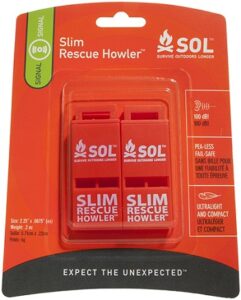 You’ve fallen on the trail, and you can’t get up. Grand as it would be to push a button, proclaim your dilemma and have help magically appear, you’re in the wild with no cell service. What you need is a whistle, a strong whistle that you can toot three times to signal you’re in distress. A signal that can be heard a mile away. You need the Slim Rescue Howler Whistle from SOL (Survive Outdoors Longer, in case you were thinking something else). The whistle is small, emits a 100db signal, and weighs just a few grams. It fits easily in a pocket, or to a zipper pull. Best of all, it comes in a pack of two, so your hiking buddies and can toot back that they’ve heard you and are on the way. $10 for the both of ‘em Learn more here.
You’ve fallen on the trail, and you can’t get up. Grand as it would be to push a button, proclaim your dilemma and have help magically appear, you’re in the wild with no cell service. What you need is a whistle, a strong whistle that you can toot three times to signal you’re in distress. A signal that can be heard a mile away. You need the Slim Rescue Howler Whistle from SOL (Survive Outdoors Longer, in case you were thinking something else). The whistle is small, emits a 100db signal, and weighs just a few grams. It fits easily in a pocket, or to a zipper pull. Best of all, it comes in a pack of two, so your hiking buddies and can toot back that they’ve heard you and are on the way. $10 for the both of ‘em Learn more here.
Reviews
2024’s best little knives
![]() GearLab, the Consumer Reports of outdoor gear, also appreciates the importance of little knives. Over the past decade they’ve tested more than 45 pocket knives, 21 of which were considered for their Best Pocket Knife of 2024 review, released in November. As always, they rank them on various factors, from Best Buy to Top Pick. All specs are included. Check out the review here.
GearLab, the Consumer Reports of outdoor gear, also appreciates the importance of little knives. Over the past decade they’ve tested more than 45 pocket knives, 21 of which were considered for their Best Pocket Knife of 2024 review, released in November. As always, they rank them on various factors, from Best Buy to Top Pick. All specs are included. Check out the review here.
Knives, multitools
Morakniv Knife and Fire Starter
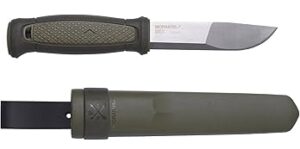 This is much more than your run-of-the-mill knife. Or fire starter. In fact, it’s both wrapped into one.
This is much more than your run-of-the-mill knife. Or fire starter. In fact, it’s both wrapped into one.
This extremely sharp knife is flexible and all around sturdy. In the handle you’ll find a fire starter. With this one tool you can split kindling, light a campfire, and gut and clean a fish. The fire starter works equally well when wet, and has predictable performance at all altitudes (unlike many other methods). Additionally, it lights not only wood, but also starts gas-stoves and barbecues. The sheath comes equipped with a clip so you can have it close by at all times. This little knife will have you prepared to trek through a blizzard or through the Amazon — and fire up the stove for a spot of tea en route. About $28. Check it out here.
TSA knives
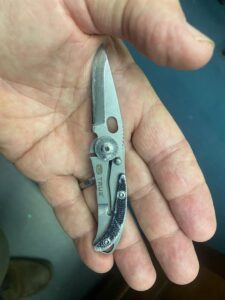 Need a multi-tool or knife cheap? Better still, need a signature gift you can give to all your outdoorsy friends that will have them saying, in the good way, “Oh, you shouldn’t have?” Ever wonder what TSA does with all those knives, multi-tools and other pointy objects they confiscate at airport checkin from people who forgot (usually) they were carrying? In North Carolina, they wind up with State Surplus Property and are sold to the public at ridiculously low prices. Benchmade knives, folding knives, Kershaw knives, buck knives, multi-tools and more, you’ll find them all at State Surplus stores in Raleigh, Chapel Hill, Greensboro, Greenville, Wilmington and Pembroke. For more on these locations and State Surplus in general, go here.
Need a multi-tool or knife cheap? Better still, need a signature gift you can give to all your outdoorsy friends that will have them saying, in the good way, “Oh, you shouldn’t have?” Ever wonder what TSA does with all those knives, multi-tools and other pointy objects they confiscate at airport checkin from people who forgot (usually) they were carrying? In North Carolina, they wind up with State Surplus Property and are sold to the public at ridiculously low prices. Benchmade knives, folding knives, Kershaw knives, buck knives, multi-tools and more, you’ll find them all at State Surplus stores in Raleigh, Chapel Hill, Greensboro, Greenville, Wilmington and Pembroke. For more on these locations and State Surplus in general, go here.
Station IX Trail Ultra neck knife
 A neck knife — a knife worn around your neck for easy access in the event of trouble on the trail — wasn’t something I’d given much thought to. Until I saw The Prepared Wanderer’s review of the Station IX Trail Ultra (also called the Number 7). The small knife, about 3 inches in length, fits in a sheath attached to a chain that you can hang around your neck. You get into trouble and don’t have time to fetch your knife out of your pack, it’s right there. What makes it especially attractive is your ability to customize it into a versatile survival kit (see Media: The Prepared Wanderer). $50. More info here.
A neck knife — a knife worn around your neck for easy access in the event of trouble on the trail — wasn’t something I’d given much thought to. Until I saw The Prepared Wanderer’s review of the Station IX Trail Ultra (also called the Number 7). The small knife, about 3 inches in length, fits in a sheath attached to a chain that you can hang around your neck. You get into trouble and don’t have time to fetch your knife out of your pack, it’s right there. What makes it especially attractive is your ability to customize it into a versatile survival kit (see Media: The Prepared Wanderer). $50. More info here.
Food
Tuna packets
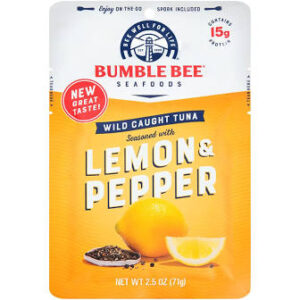 Lunch on those long hikes — like those you’re taking this fall — presents a conundrum. You want it to be nutritious and fuel-efficient, you also want it to be tasty. One popular option has long been tuna, what with its high protein content. Trouble is, tuna typically needs a little help to catapult it into the tasty category. The Bumble Bee people have not only injected tasty into the mix with its new line of flavored Snack Kits (Spicy Thai Chili, Lemon & Pepper, Sun Dried Tomato, to name three), but they’ve also added convenience: the 2.5-ounce servings come in a pouch that includes a little spoon! Each packet also provides 15 grams of protein (if just 70 calories). Topping out on 5,520-foot Standing Indian Mountain this past Saturday after a 6.6-mile climb, I was pleasantly surprised by my Chipotle tuna, which had a mild, but not overwhelming, kick. Convenient, they taste good, and they’re only a little more than $1 a pack. Check out your options here.
Lunch on those long hikes — like those you’re taking this fall — presents a conundrum. You want it to be nutritious and fuel-efficient, you also want it to be tasty. One popular option has long been tuna, what with its high protein content. Trouble is, tuna typically needs a little help to catapult it into the tasty category. The Bumble Bee people have not only injected tasty into the mix with its new line of flavored Snack Kits (Spicy Thai Chili, Lemon & Pepper, Sun Dried Tomato, to name three), but they’ve also added convenience: the 2.5-ounce servings come in a pouch that includes a little spoon! Each packet also provides 15 grams of protein (if just 70 calories). Topping out on 5,520-foot Standing Indian Mountain this past Saturday after a 6.6-mile climb, I was pleasantly surprised by my Chipotle tuna, which had a mild, but not overwhelming, kick. Convenient, they taste good, and they’re only a little more than $1 a pack. Check out your options here.
